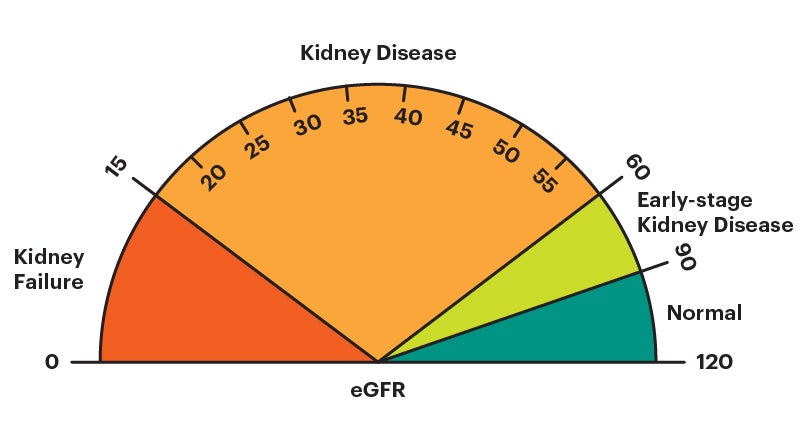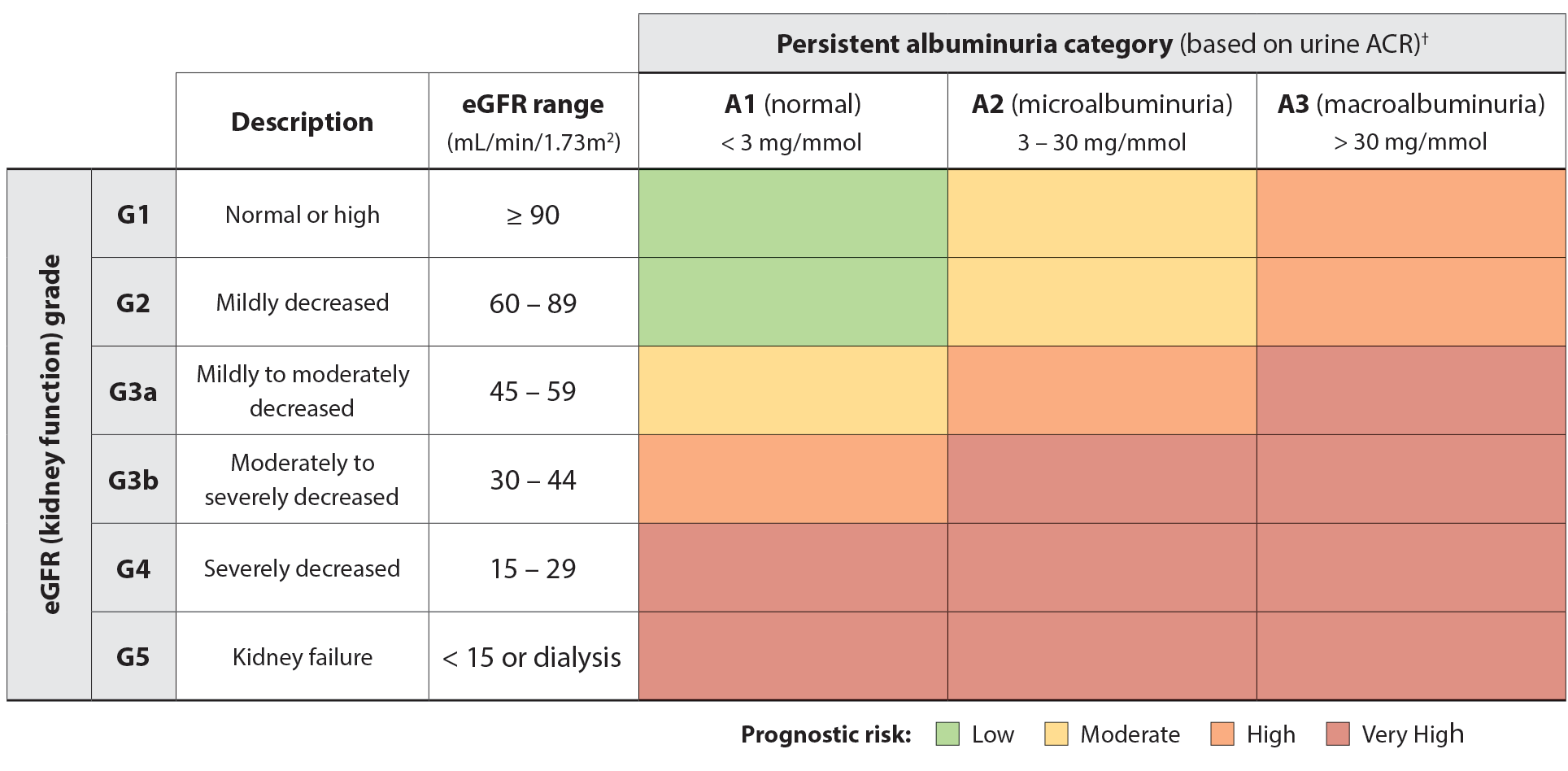What are the 5 stages of CKD?
Keep track of your kidney data with PKB
Key Points
- There are 5 stages (grades) of CKD, from CKD1 (risk factor) to CKD5 (kidney failure)
- CKD stage is based on a blood test called eGFR – the higher the eGFR value, the lower the grade of CKD, the better the kidney function
- Most people have lower grades of CKD and never need dialysis
- 1 in 100 patients with CKD end up needing dialysis or a kidney transplant
- The KFRE (Kidney Failure Risk Equation) is a tool used to predict whether you may require dialysis later on in life.
We will now discuss the 5 stages of chronic kidney disease.
CKD Stages
These are the 5 stages in the CKD classification, which are based on something called ‘eGFR’ (normal is 90-120 mls/min). eGFR is a blood test which estimates the level of function of the kidney. The CKD stages describe the severity of the disease – the higher the grade (stage), the worse the kidney function.
CKD1+2 – Risk factor for developing CKD (eGFR 60-120 mls/min)
- Symptoms: no symptoms
- Treatment: no specific treatment for this stage of CKD. Risk factors for CKD should be looked at and treated if needed (for example high blood pressure). A risk factor in this example is a lifestyle or environmental factor that increases the chance of developing a medical condition.
CKD3A+B – Mild CKD (eGFR 30-59 mls/min)
- Symptoms: no symptoms or mild symptoms
- Treatment: treating the cause of CKD and making sure blood pressure and blood sugars are in the correct range (if diabetic). This will help stop CKD worsening.
CKD4 – Moderate CKD (eGFR 15-29 mls/min)
- Symptoms: moderate
- Treatment: treat cause of CKD and ensure blood pressure and blood sugars are in the right range.
Note. Some patients need to prepare for dialysis or transplant when their CKD becomes stage 4.
CKD5 – Severe CKD (kidney failure) (eGFR < 15 mls/min)
- Symptoms: severe
- Treatment: start dialysis or transplant, or give supportive care.

– CKD3B is worse than CKD3A.
– CKD4 means you may require dialysis or a kidney transplant one day.
– CKD5 means you require dialysis, or a kidney transplant, or supportive care (no dialysis).
How do we calculate the stage of CKD?
According to the CKD/GFR classification, ‘normal’ (i.e. average) GFR (function of the kidneys) in humans is 90-120 mls/min. The GFR is estimated (eGFR) based on the level of creatinine in the blood (normal range 60-120 mcmol/L); the lower the creatinine, the higher the GFR, the better is the kidney function.
So, to calculate your GFR, you first have to have the level of creatinine measured in your blood. This is part of a blood test called ‘U&Es’, which stands for ‘urea and electrolytes’. This blood test also checks the level of salts in your blood (sodium and potassium, which are important to monitor). We have more information about other investigations you may need here.
Note. It is important to note GFR does not mean % kidney function. This is because GFR is measured in mls/min and not %. The eGFR blood test only describes one of the 7 functions of the kidneys, the remaining functions of the kidney are described in what do the kidneys do.
Why do we assess creatinine, eGFR and CKD stage?
It enables us to:
- Diagnose CKD – by assessing one of the 7 function of the kidneys (waste removal). There are 6 other functions
- Assess CKD severity
- Explain the outlook (prognosis) – for the patient. This is based not just on the level of creatinine/CKD/eGFR but the rate of change of these measurements. The Kidney Failure Risk Equation (KFRE; below) is useful for long term predictions.
Is CKD a disease? Or even a diagnosis?
That’s a hard one. Not really to both. In its early stages, it is a risk factor for a syndrome. In its later stages, it is really a syndrome, with many causes. A syndrome is a common presentation (set of symptoms with typical blood tests) that can have many causes (each being an individual disease, like glomerulonephritis or polycystic kidney disease).
Yes, it is complicated (“Ok, we get that!” CKDEx Ed”). It is a bit like ‘anaemia’, which means a lack of red blood cells in the blood. That is also a syndrome (set of symptoms) with many (disease) causes.
Risk factor vs Disease
Even though CKD is an abbreviation for Chronic Kidney Disease, for many people at the less severe end of the CKD classification (CKD1+2, and CKD3a), it is really a risk factor (something that increases the chance of developing worsening CKD)– and not a disease itself. Being told you have CKD3 can be scary. It needs to be explained and put into perspective by your doctor.
Luckily serious kidney disease – i.e. CKD5, which is considered kidney failure – is rare. So, luckily, few patients with CKD go on to need dialysis or a kidney transplant.
CKD stage and urine ACR (protein level)
Just to make things more complicated doctors describe CKD not just with GFR but also by a urine test which measures the level of protein (albumin) in the urine. This is called the urine ACR (or uACR). Albuminuria is the name given to albumin protein in the urine. For many, the higher the level of protein in the urine the worse the kidney function.
Urine ACR is combined with the CKD stage (Grade or ‘G’ 1-5) to estimate the outlook for someone with CKD. In other words, CKD can be described in one patient as ‘CKD G4 A3’ (this abbreviation means CKD stage 4, urine ACR >30mg/mmol). This has a worse outlook, for example, than for a patient with ‘CKD G2 A1’.
In other words a higher level of albuminuria (protein in the urine) worsens the outlook for CKD patients, as does a lower GFR. The table below helps explain this issue.
[“Yes, it’s complicated. Sorry” CKDEx Ed].

Progression of CKD
Patients do not necessarily progress from CKD1 to 2 to 3 etc. They may stay at CKD3A for example, or even return to normal.
What is the Kidney Failure Risk Equation (KFRE)?
The KFRE is a maths equation that can predict how high or low your chance (risk) is for reaching kidney failure (CKD5) within the next 2-years and next 5-years. Results are given as a percentage (%) on a scale of less than 1% to 99%. For example, a result of 1% means you have a 1% chance of reaching kidney failure within 2 years. A 5% chance of reaching kidney failure in 5 years is considered low.
To calculate KFRE requires the following information:
- Age in years
- Gender
- eGFR (ml/min)
- Urinary protein (called urinary ACR, or uACR).
Here is an KFRE equation you can use to calculate yours.
Summary
We have described what are the 5 stages of CKD – and how to use the KFRE to predict your outcome. The CKD classification is used to diagnose CKD, and assess its severity. We hope you understand it better now.
Top Tip
If you have CKD, ask the doctor to calculate your KFRE (or you can!).
This will give you a quite accurate prediction on whether you will ever need dialysis, and/or need to see a kidney specialist (nephrologist).
https://www.youtube.com/watch?v=iV_pRlmBar8
Last Reviewed on 22 June 2024
